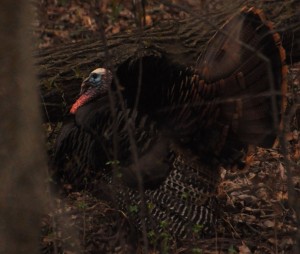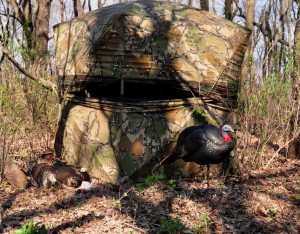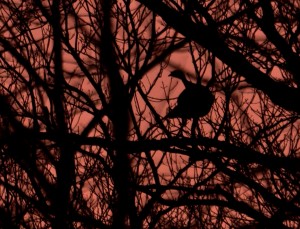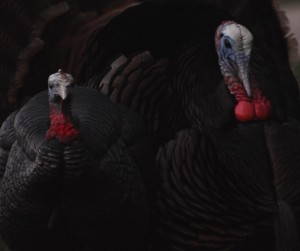Photography courtesy of Lowell Washburn, all rights reserved.
Once in a Blue Moon there are times when wild turkeys follow the script and the hunt goes exactly as planned.
We’ve all heard and read about those mythical Text Book Turkey Hunts. You know, the hunts where the weather is perfect, the calling is perfect, and the Old Swamp Gobbler you’ve been plotting against for weeks comes roaring into your set with each and every move going exactly as planned.
Unfortunately, such dream hunts are usually just that – dreams. And all too often we leave the woods with our tails between our legs while Mr. Long Beard lives to gobble another day. Occasionally, however, those imagined dream hunts become a true reality. This morning, I had the rare opportunity to enjoy just such a hunt.
I started the day by arriving at the woods a whole lot earlier than I really needed to; there wasn’t even the slightest hint of light anywhere in the east. Nevertheless, I grabbed my gear and immediately headed out, slowly making my way to what was more or less the center of the property. Popping up my blind and placing a single jake decoy nearby, I settled in and waited for daylight.
While it still mostly dark [about 5:40 am] I was surprised when a gobbler suddenly sounded from an adjacent woodlot located about a quarter mile distant. I was greatly encouraged when he was answered by a second tom – a bird that must have been less than 75 yards to my side. The gobbling was soon joined by a third tom, located somewhere to the east.
As daylight slowly increased, the intensity of the gobbling followed suit. When I let out a few soft tree yelps, and the nearest gobbler went ballistic. Close range gobbling is the sound turkey hunters live for, and for the next twenty minutes I got plenty of it.
Too much calling will frequently cause incoming gobblers to hang up – or to stay in the tree. Although the woodland floor was still too dark for a shot, I could tell the closest tom was thinking about flying down. In an attempt to keep him roosted, I decided to “over call”. The tactic worked and for the next ten minutes, the gobbler and I conducted a very active conversation. He eventually couldn’t take it anymore, and left the roost with a twig snapping rush of wings – touching down near the base of tree located 25 yards distant. The gobbler stood at attention for a few seconds, then quickly relaxed, and immediately emitted a leaf shaking series of gobbles. Inside the blind, I was conducting my own spring ritual by sprouting an impressive crop of goose bumps the size of ping pong balls.
After quietly knocking an arrow on the bow string, I emitted a louder series of calls. Gobbling in response, the tom went into full strut and began his advance. Once on the move, the gobbler never stopped and the rest of the story played out in seconds. Never leaving the strut, the tom arrived at the jake and began pushing against the decoy. Although I gave one more call on the wing bone, the bird remained silent. The only sounds were his drumming and the close range dragging of wings.
Pulling the bow, I let the arrow fly. Still in the strut, the gobbler did an Olympic Grade back flip and began to thrash his wings. Next, the recently deceased turkey loudly flailed his way to my blind. For the next few seconds, he continued to thrash the forest floor with one wing and the side of my canvas blind with the other. Then, as quickly as it had started, everything was silent.
Once I realized the bird was in the bag, I once again became aware of my surroundings. The first tom I’d heard – the one that started the morning a quarter mile away — was now throwing a running gobbling tantrum as he made his way in my direction. The increasing sound told me that the turkey was in a full out sprint, no doubt incited by what must have sounded like a World Class turkey fight in the vicinity of my blind.
Grabbing the camera, I knew a turkey photo op was eminent. But then a hen suddenly cranked up between me and the incoming gobbler and the show was over. Although I could still hear the yelping hen 15 minutes later, the tom had gone totally silent. Not getting to see the gobbler, I opted to photograph the slain bird from the inside of the blind.
About 8:30, the gobbler – at least I assumed it was the same one — began to crank up again. But although the bird continued to respond to the call, he had lost much of his initial fire. The tom was still gobbling when I finally decided to call it quits and leave the woods at ten o’clock. Never did catch a glimpse of that turkey.
The tom I bagged ended up being a three or four-year-old bird weighing 22 pounds with needle sharp, one inch spurs.
LW






 Tom Cope
Tom Cope Sue Wilkinson
Sue Wilkinson Susan Judkins Josten
Susan Judkins Josten Rudi Roeslein
Rudi Roeslein Elyssa McFarland
Elyssa McFarland Mark Langgin
Mark Langgin Adam Janke
Adam Janke Joe Henry
Joe Henry Kristin Ashenbrenner
Kristin Ashenbrenner Joe Wilkinson
Joe Wilkinson Dr. Tammy Mildenstein
Dr. Tammy Mildenstein Sean McMahon
Sean McMahon